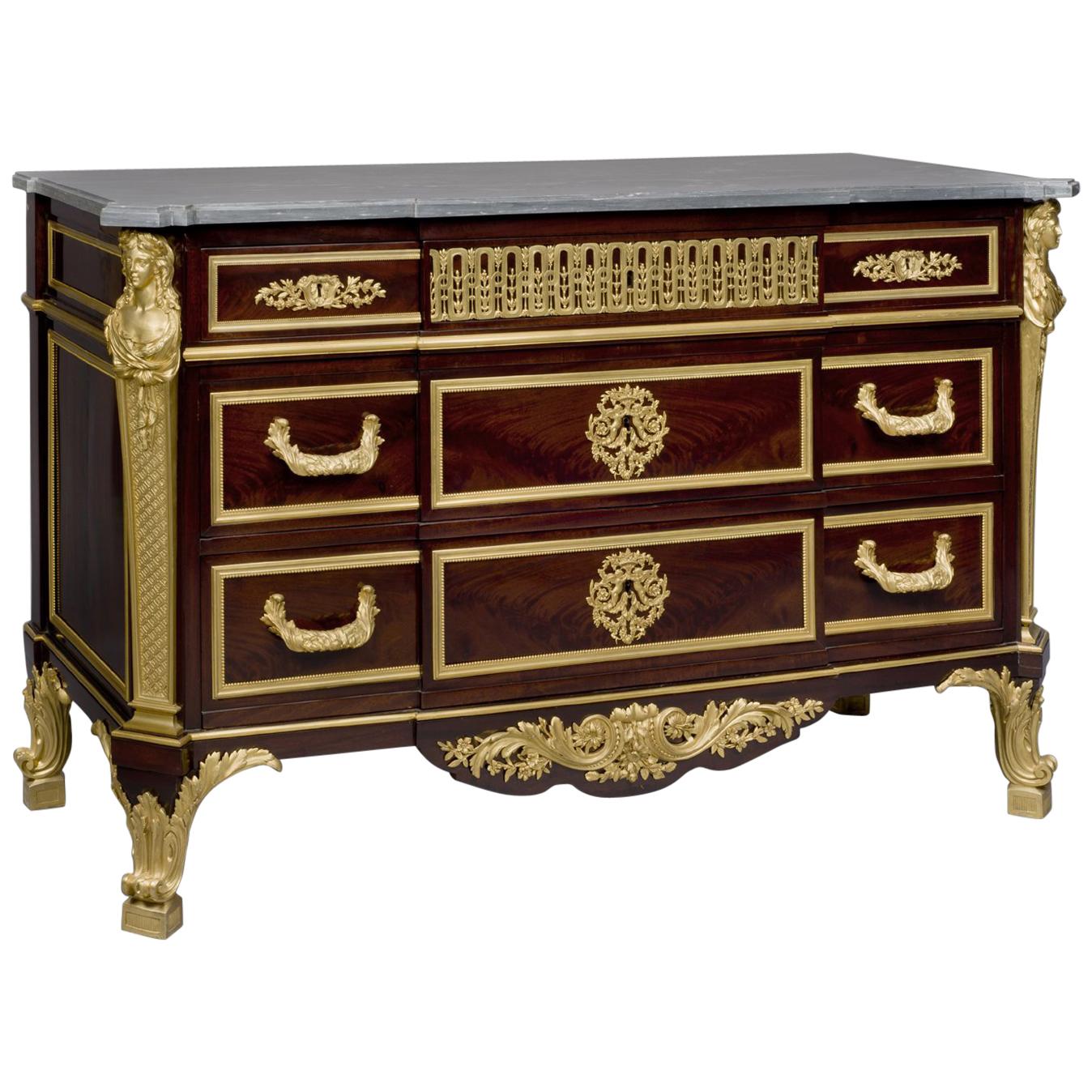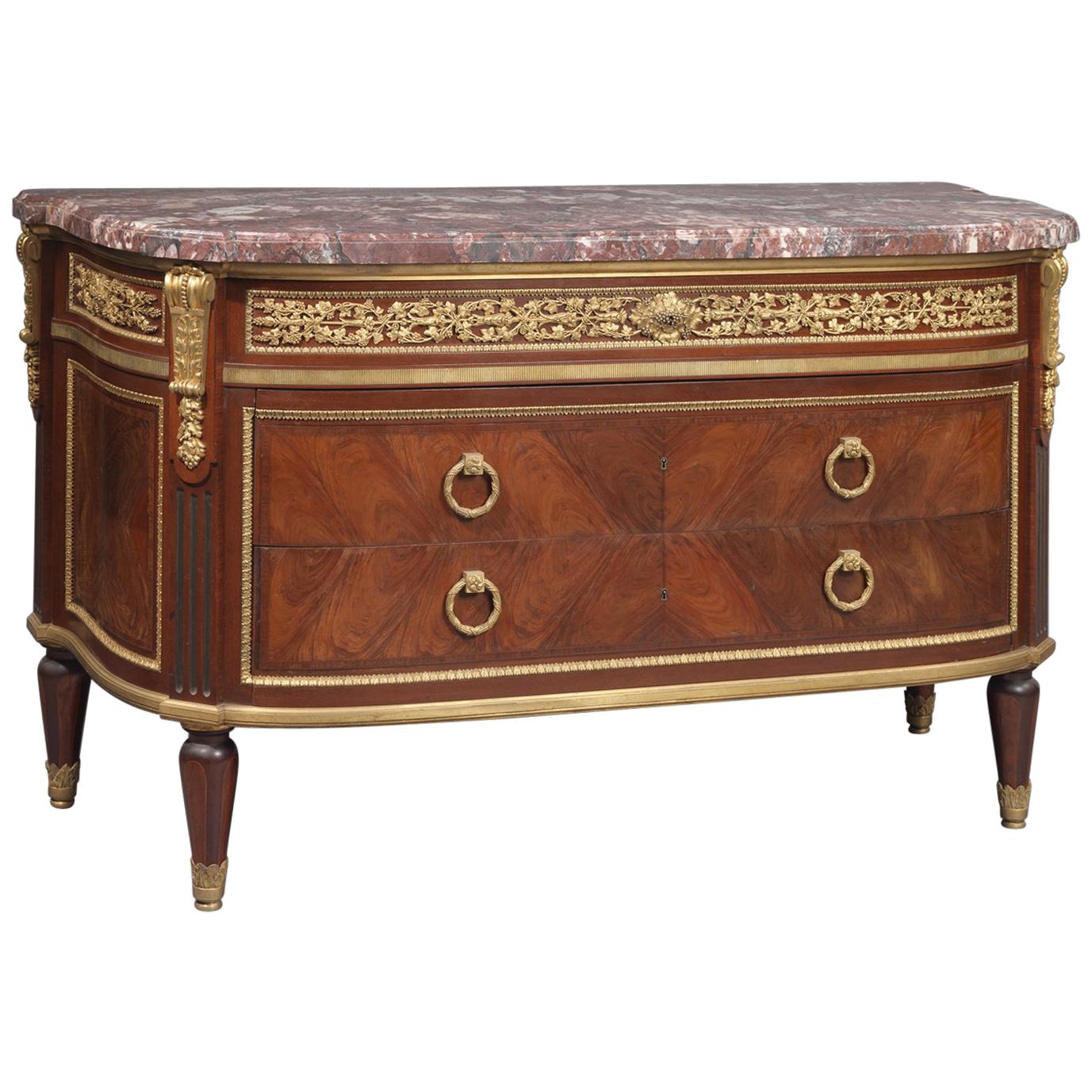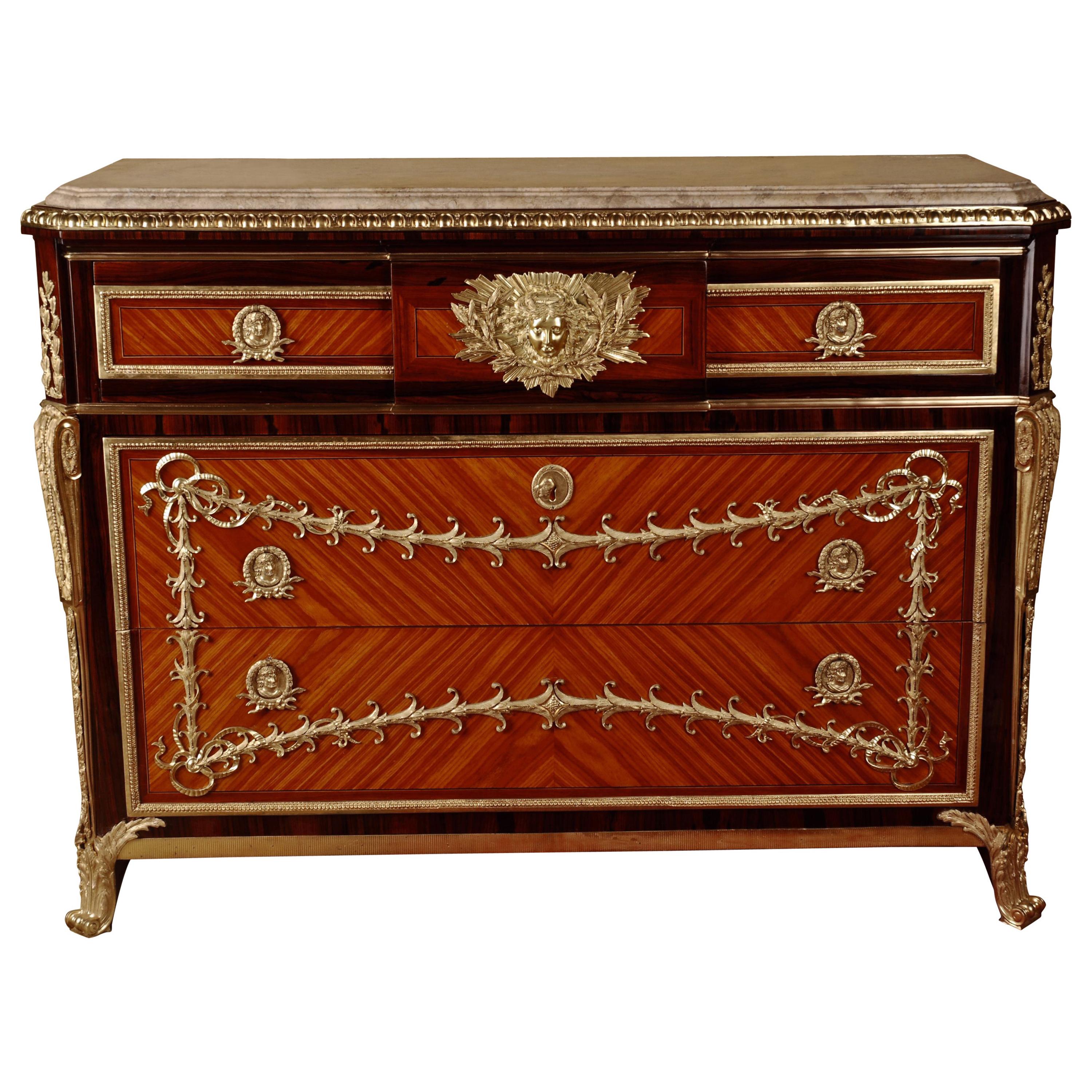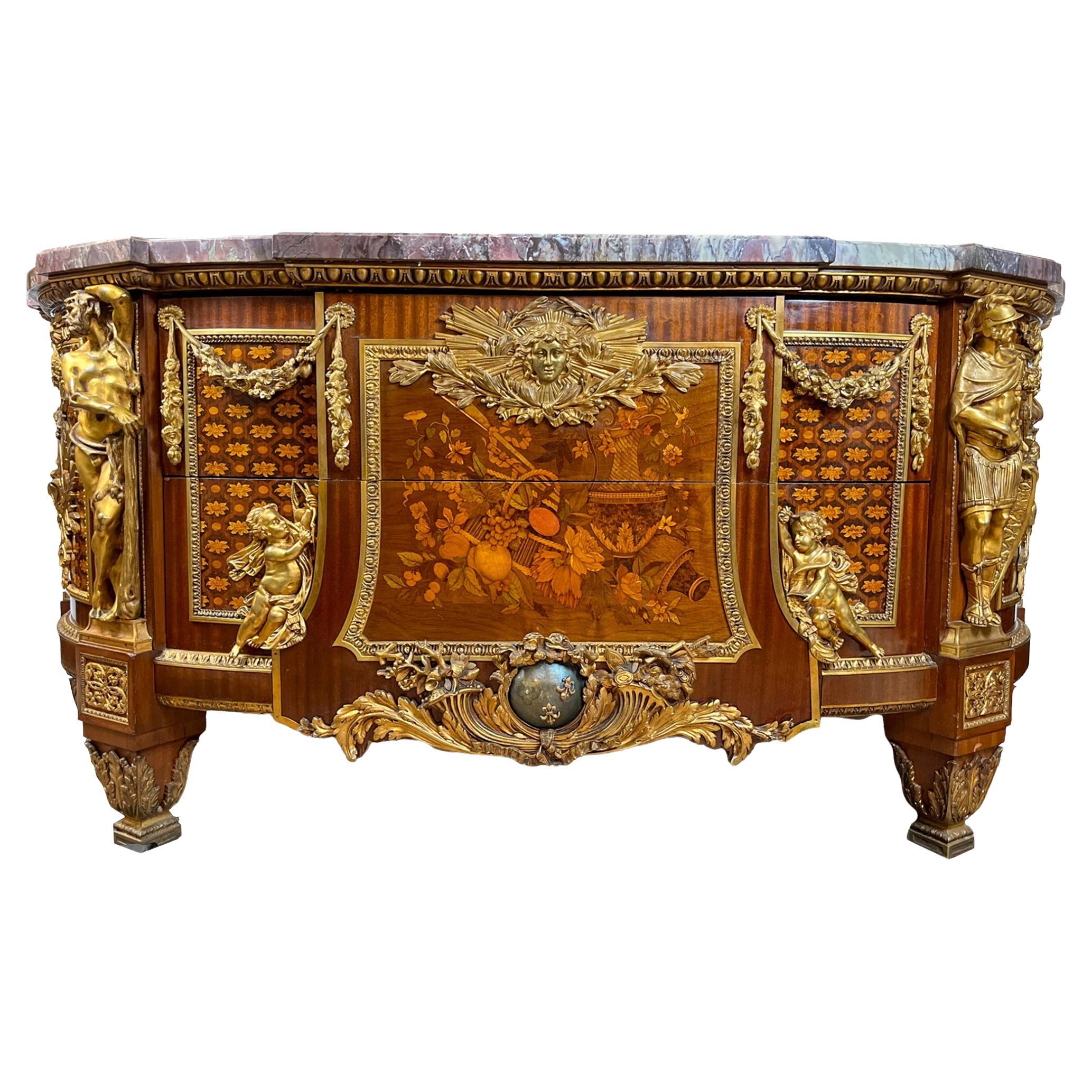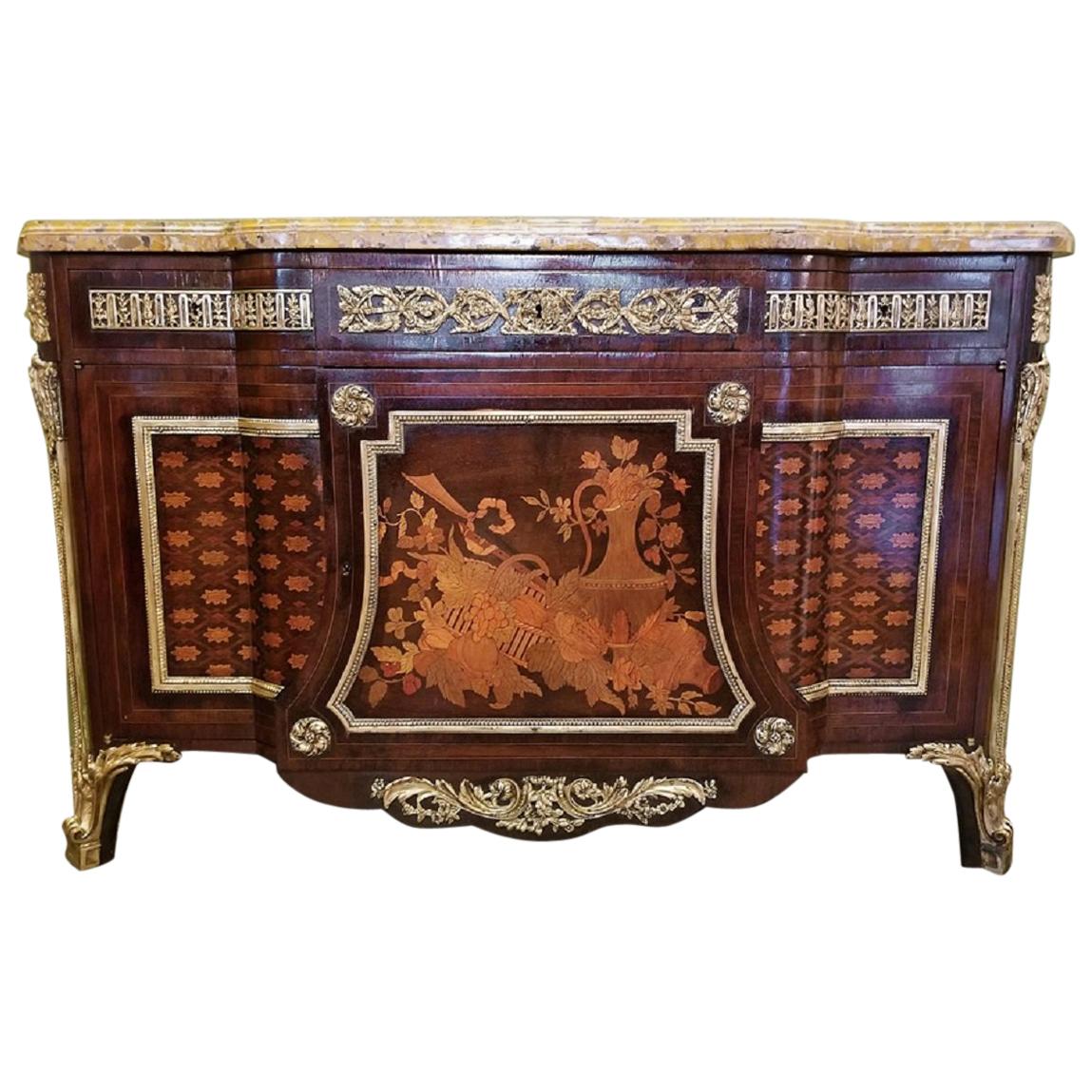Louis XVI Style Commode after Jean-Henri Riesener by François Linke, circa 1905
About the Item
- Creator:François Linke (Cabinetmaker)
- Similar to:Jean-Henri Riesener (Cabinetmaker)
- Dimensions:Height: 37.01 in (94 cm)Width: 65.75 in (167 cm)Depth: 25.6 in (65 cm)
- Style:Louis XVI (In the Style Of)
- Materials and Techniques:
- Place of Origin:
- Period:1900-1909
- Date of Manufacture:circa 1905
- Condition:
- Seller Location:Brighton, GB
- Reference Number:
François Linke
François Linke, the most important French ébéniste of his time. Born in Bohemia in 1855, Linke moved to Paris in 1881 where he established his now-famous workshop and showroom. Linke's superior work spread quickly through France and he soon eclipsed even the finest furniture houses of Paris. Today, Linke is counted among the most important furniture makers of the late 19th and early 20th centuries, and his work is dearly coveted by collectors. Linke is celebrated for designing highly innovative furnishings by infusing the Rococo style with the Art Nouveau trends of Paris and this Louis XV style desk exemplifies his highly original style.
- ShippingRetrieving quote...Ships From: Brighton, United Kingdom
- Return PolicyA return for this item may be initiated within 7 days of delivery.
- Louis XVI Style Commode after the Model by Jean-Henri Riesener, circa 1880By Jean-Henri RiesenerLocated in Brighton, West SussexA fine Louis XVI style gilt bronze-mounted mahogany commode, with a blue turquin marble top after the model by Jean-Henri Riesener. French, circa 1880. The gilt bronze mounts s...Category
Antique Late 19th Century French Louis XVI Commodes and Chests of Drawers
MaterialsMarble, Bronze
- Louis XVI Style Commode after the Model by Leleu by François Linke, circa 1910By François LinkeLocated in Brighton, West SussexAn important Louis XVI style gilt bronze-mounted commode, after the model by Jean-Francois Leleu by François Linke. French, circa 1910. Linke index number: 1127. Linke title: 'Commode Louis XVI, Bois d'amarante et de rose.' Signed ‘Linke’ to the right-hand side chute. This distinguished commode is quarter veneered in mahogany with bois de violette banding and boxwood stringing. It is furnished with finely cast gilt-bronze mounts and surmounted by a brèche violette marble top. It appears that Linke bought the rights to make this commode from the Vente Cueunières in 1902, although there is no trace of it being made by him until the summer of 1908 and there is no entry in the Blue Daybooks for this model. The green registres have two pages devoted to the making of the commodes, the first at a cost of 1,540 and 40 centimes, with eight more made in the intervening years, the last, a pair, in 1927 with the cost price escalating to 8,529 francs. The registre is not entirely clear, but it appears that Clément Linke, father and son, made the locks for this model. The cabinetmaking was exclusively by Guntren who took 496 hours per commode, paid 85 centimes in 1908 rising to 5 francs 75 cents for the last pair. Linke priced this commode at 3,000 French francs, noting in his book 'original est de Leleu est à Trianon.' The original commode by Leleu, on loan from the Petit Trianon, is shown in a line engraving in the retrospective part of the Exposition de l' Union Centrale des Arts Décoratifs, Paris, 1882, De Champeau & Others, 'Les arts du bois,' pub. Quantin, 1883, p. 80. The commode entered the Petit Trianon in 1867 on the occasion of an earlier exhibition dedicated to the memory of Marie-Antoinette, organised under the patronage of the Empress Eugénie. Jean-François Leleu A pupil and later collaborator with Jean-François Oeben, Jean-François Leleu became maître on the latter’s death in 1763. His work can be divided into two concurrent but distinct styles: the first owing more to the legacy of Oeben, being of large, solid forms, more noble in style; the second, although retaining the clean, definite lines of the first, being an exercise in elegance and understatement. It is this second style for which Leleu is chiefly remembered and which the present commode, with its lightly bombé form and restrained frieze mounts, is a principal example. Literature: Payne, Christopher. François Linke, 1855-1946, The Belle Epoque of French Furniture, (woodbridge, UK), 2003; p. 502, for the black and white cliché of index number 1127 Meyer, Jonathan. Great Exhibitions, Antique Collectors club, (Woodbridge, UK), 2006; p. 298 - 300. Pradère, Alexandre. French Furniture Makers; p. 340, fig. 398; and P. Arizzoli-Clementel. Versailles Furniture...Category
Early 20th Century French Louis XVI Commodes and Chests of Drawers
MaterialsBronze
- Louis XVI Style Marquetry Writing Table after Jean-Henri Riesener, circa 1870By Jean-Henri RiesenerLocated in Brighton, West SussexA Louis XVI style gilt bronze mounted mahogany and Marquetry inlaid writing table after the model by Jean-Henri Riesener. This finely inlaid writing ...Category
Antique Mid-19th Century French Louis XVI Desks and Writing Tables
MaterialsBronze
- Louis XVI Style Neoclassical Commode in the Manner of Riesener, circa 1890By Jean-Henri RiesenerLocated in Brighton, West SussexA Fine Louis XVI Style mahogany and Marquetry Inlaid neoclassical breakfront commode in the manner of Jean-Henri Riesener. French, circa 189...Category
Antique Late 19th Century French Louis XVI Commodes and Chests of Drawers
MaterialsBronze
- Louis XV Style Marquetry Commode, Possibly by François Linke, circa 1900By François LinkeLocated in Brighton, West SussexA Louis XV style gilt bronze mounted marquetry commode with marble top, possibly by François Linke. French, circa 1900. Stamped 'Mon LEGER' to the back of the commode for the retailer Émile Léger...Category
Antique Late 19th Century French Louis XV Commodes and Chests of Drawers
MaterialsBronze
- Louis XVI Style Commode after a Model by Jean-François Leleu, circa 1870Located in Brighton, West SussexA Fine Louis XVI Style gilt bronze Mounted Commode after a Model by Jean-François Leleu. French, circa 1870. This important commode has a moulded rectangular Brocatelle Violette du Jura marble top above a frieze drawer with a pierced foliate cast panel, above two panelled long drawers quarter-veneered sans travers. The fluted angles of the commode are headed by scrolled acanthus cast clasps and it is raised on turned tapering legs with toupie feet. The commode is based on the celebrated 18th century model, by Jean-François Leleu (1729-1807), now conserved at the Petit Trianon at Versailles. It was placed there in 1867 following an exhibition organised at the request of Empress Eugénie in memory of Queen Marie-Antoinette. The commode was further exhibited in Paris in the retrospective part of the Exposition de l' Union centrale des arts décoratifs in 1882. Literature: Exposition de l' Union centrale des arts décoratifs, (Paris), 1882. De Champeau & Others. Les arts du bois, pub. Quantin, 1883; p. 80. P. Arizzoli-Clementel. Versailles Furniture...Category
Antique Late 19th Century French Louis XV Commodes and Chests of Drawers
MaterialsMarble, Bronze
- 20th Century Louis XV Style Corner Commode After Jean Henri RiesenerBy Jean-Henri RiesenerLocated in Berlin, DEBronze of exceptional quality. Marble panel, over frieze drawer and a large barrier door flanked by corner fittings with acanthus volutes and garlands, with amaranth, bergahorn and c...Category
20th Century Louis XV Commodes and Chests of Drawers
MaterialsMarble, Bronze
- 20th Century Transition Style Commode after Jean Henri RiesenerBy Jean-Henri RiesenerLocated in Berlin, DECommode after the original model from Jean Henri Riesener in transition style. Lightly modified model after an original by Jean Henri Riesener (1...Category
20th Century French Commodes and Chests of Drawers
MaterialsBronze
- Louis XVI Style Fruitwood Marquetry Commode Modeled After Jean-Henri ReisenerBy Jean-Henri RiesenerLocated in New York, NYExceptional French Louis XVI Style Gilt-Bronze Mounted, Mahogany and Fruitwood Marquetry and Parquetry, Armorial Commode with original Marble Top, aft...Category
Antique Late 19th Century French Louis XVI Commodes and Chests of Drawers
MaterialsBronze
- 19th Century Louis XVI Style Commode After Jean Henri ReisenerBy Jean-Henri RiesenerLocated in Dallas, TXPresenting an absolutely stunning 19th century Louis XVI style, Harewood and Kingwood commode after the model made by Jean Henri Reisener. We are of the opinion that our Commode is a mid to late 19th century copy of the original Reisener commode...Category
Antique Late 19th Century French Louis XVI Commodes and Chests of Drawers
MaterialsKingwood, Harewood
- 20th Century Commode/Console after Jean Henri Riesener, goldBy Jean-Henri RiesenerLocated in Berlin, DE20th Century Commode/Console after Jean Henri Riesener, gold Commode after the original model from Jean Henri Riesener in transition style. Lightly...Category
20th Century French Commodes and Chests of Drawers
MaterialsBronze
- 19th Century French Gilt-Bronze Mounted Commode after Jean-Henri RiesenerBy Jean-Henri RiesenerLocated in Los Angeles, CAA Superb 19th century French Louis XVI style gilt- bronze mahogany, kingwood and fruitwood marquetry armorial commode with Sycamore Marquetry and magn...Category
Antique Late 19th Century French Louis XVI Commodes and Chests of Drawers
MaterialsOrmolu
